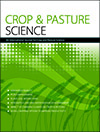Understanding of interception, absorption and translocation of exogenous Zn in wheat is important to the goal of improving biofortification efficacy; however, knowledge gaps exist with regard to absorption and translocation of exogenous Zn by wheat and the role of spikes in biofortification. Results show that spikes are critical in intercepting and absorbing exogenous Zn, and translocation of exogenous Zn is dependent on application stage. The outcomes improve our knowledge of how wheat plants intercept, absorb and translocate Zn.

Crop & Pasture Science
Volume 75 Number 5 2024
To ensure the continued existence of annual legume species in temperate regions, it is essential to understand the factors contributing to successful seed production; for instance, certain cultivars of French and yellow serradella occasionally flower at suboptimal times, potentially leading to reduced seed production. This study uncovered differences in how these cultivars produce flowers, pods and seeds. Some showed the ability to adapt to early flower loss, suggesting that selective breeding could improve seed yield resilience.
CP23324 Abstract | CP23324 Full Text | CP23324PDF (677 KB) | CP23324Supplementary Material (1.3 MB) Open Access Article
A challenge for livestock farmers is to improve production and nutritive value of forage grasses through management strategies. This study evaluated the impact of management on productive and nutritive traits of forages during two experimental years on five pasture-based production systems. More intensified systems with proper management allowed better characteristics than degraded pasture, ameliorating the effects of seasonality and improving tropical grasses in pasture-based livestock production systems.
Rankings of genotypic performance may change from one environment to the next, creating genotype × environment interaction (GEI), which can impact genomic prediction and complicate identification of superior genotypes. We compared strategies for predicting the performance of individuals in the presence of GEI. The results provide useful tools for the optimisation of training populations and testing environments for the prediction of individuals in the targeted populations of environments.
CP23126 Abstract | CP23126 Full Text | CP23126PDF (1.3 MB) | CP23126Supplementary Material (1 MB) Open Access Article
This study aimed to define the optimum cropping calendar and the agroclimatic and agroecological zones for rainfed maize (Zea mays L.) across Ceará state, situated within the Brazilian semi-arid region, assuming different rainfall scenarios: dry, regular, and rainy. The agroclimatic zoning was defined trough the crop water balance results. Our findings demonstrated that rainfed maize cultivated under the semi-arid climate of Ceará state is viable in rainy conditions, partially restricted in regular years, and not recommended in dry years.
The seasonality between the rainy and dry seasons is a challenge for tropical agriculture. This study evaluated different forms of ensiling Tanzania grass (Megathyrsus maximum) and forest pasture hay (FPH) aiming to improve the conservation and nutritional value of silages. Results showed that the use of 30% FPH improved the fermentative processes and the nutritional value of the silages. This strategy can reduce the negative impacts of weeds on pastures, although further research is needed for complementary additives.




